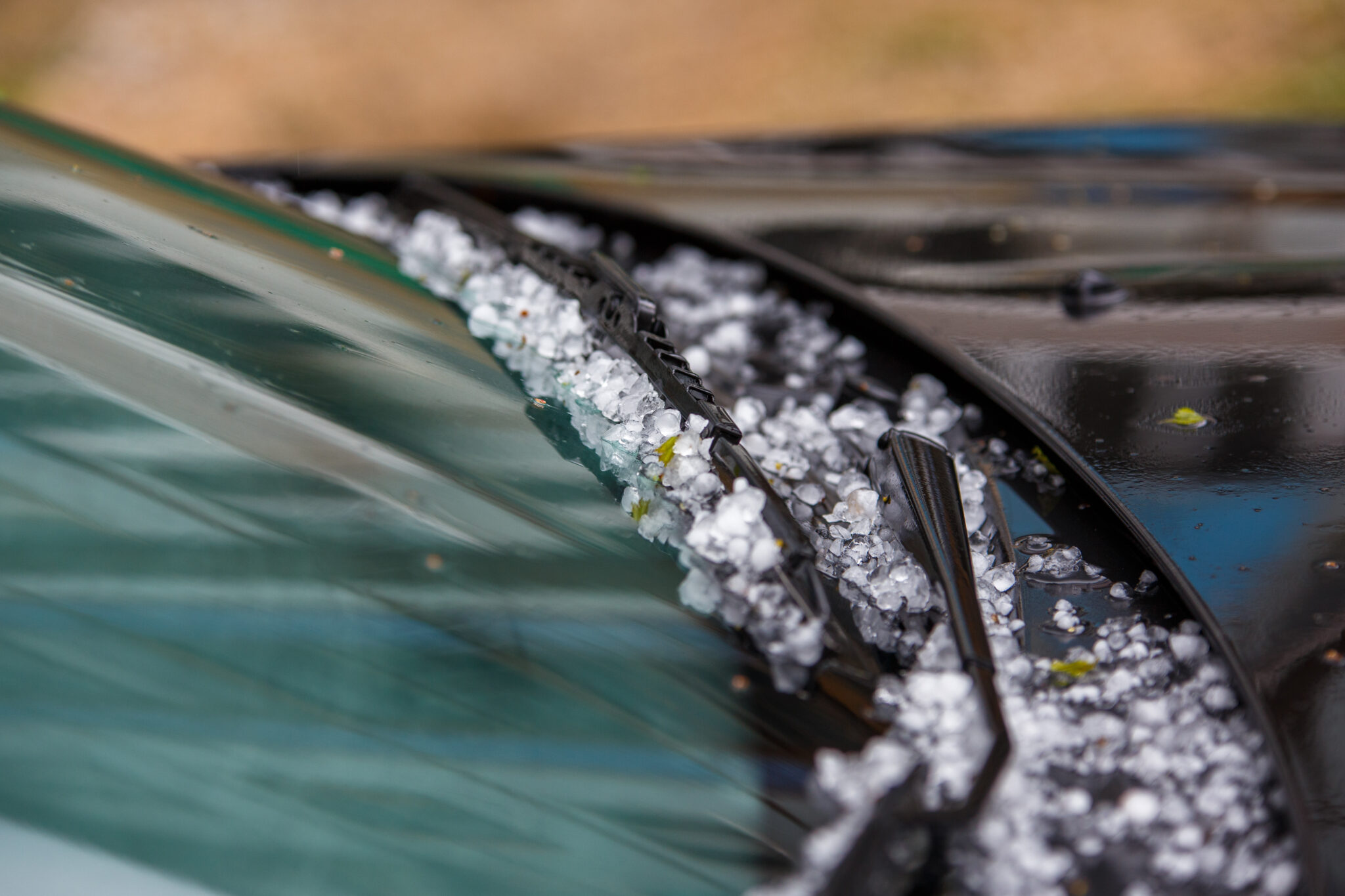A hailstorm can severely damage your car. In some cases, per the National Severe Storms Laboratory (NSSL), hailstones can reach the size of a golf ball or even get as big as a grapefruit.
You may wonder if your auto insurance will cover you if your car’s been damaged in a hailstorm. In this article, you’ll learn all you need to know about how your policy covers hail damage. We’ll go over:
- What type of insurance covers it
- If you pay a deductible
- What to do if your car has hail damage
- What to do if you have a rental car
- Frequently asked questions
Comprehensive Coverage and Hail Damage
Comprehensive insurance deals with damages to your car because of hail. If you have it, you’ll only have to pay your set deductible. Your insurer will cover the remaining repair costs up to your limits.
Comprehensive is one of the three pillars of full coverage insurance that pays for damages from incidents beyond your control. A few examples of these events include hailstorms, falling trees, and other things that aren’t collisions.
Below is a list of some incidents that comprehensive auto coverage handles:
- Storms, tornadoes, earthquakes, and more
- Running into an animal
- Falling trees, light poles, and other debris
- Vandalism
- Vehicle theft
Hailstones can damage any part of your car, including leaving many dings and dents on your car’s body. But they primarily can lead to a cracked windshield. You could lose visibility and will need to replace your windshield if it gets too many cracks on it from a hailstorm. Keep in mind that you’ll be out of luck if you only have liability insurance. Without comprehensive on your policy, you must pay out of pocket for all repairs.
It’s also important to note that collision coverage won’t help repair your car after it’s damaged in a hailstorm. Collision only covers damages to your vehicle if you collide with a car or other objects, such as trees or poles.
Do I Have to Pay a Deductible?
Comprehensive insurance has a deductible that you must pay if you file a hail damage claim. A deductible is how much you’ll pay to get your car fixed before your coverage pays for the remainder. Any time you make a collision or comprehensive claim, you’ll need to pay your deductible.
There are some occasions when you might not want to make a claim. For instance, you wouldn’t want to file if you have a $1,000 deductible, but the damages are $900. You’d end up paying for all your car’s repairs yourself if this were the case.
Windows and Your Deductible
Sometimes your insurance company could even waive your deductible if your window is only repaired and not completely replaced.
You could also get enhanced windshield coverage, which is a type of add-on that takes care of windshield damage without you having to pay a deductible. This is a good idea if your comprehensive deductible costs more than your car’s repairs.
What to Do If Your Car Is Damaged By Hail
Hail can be hard to predict and can seemingly appear out of nowhere. If the skies open and hailstones damage your car, you’ll likely wonder what’s next to get your car back to normal. The best thing you can do is find out how bad the damages are and decide if you want to tell your insurance provider.
Below are some steps you can take if your car has hail damage:
Assess and Document the Damage
After a hailstorm, walk around your vehicle and look closely to see if it has damages such as body dents or a cracked windshield. If it’s damaged, take photos of your car with your smartphone or camera to show to your insurance provider. It’s also a good idea to jot down some notes about the damage. This way, you can have them on hand when you talk to your insurer.
Contact Your Insurer
Get in contact with your insurer if the damage affects your ability to safely drive your car. Be sure to let them know about all the damages and follow all their instructions. They’ll be able to let you know what’s next for getting your car the proper repairs it needs.
File a Claim
Once you talk to your insurer, you’ll likely need to file a claim for your car’s hail damage. You can do this online or by directly contacting your provider. Remember that you may not want to file if your deductible costs more than the repairs would. Otherwise, you’d be paying out of pocket for everything.
Does Filing a Claim Raise Your Rates?
Reporting a claim to your car insurance company could affect your rates. One claim for hail damage likely won’t shift your auto rates too much. But be aware that multiple claims over a short period could lead to an increase in your premium, according to the National Association of Insurance Commissioners (NAIC).
Many things can affect your rates, and claim frequency is just one of them. Other common factors include things like:
- Your car’s yearly mileage
- Your driving record
- Where you live
- Your age and gender
What If Your Rental Car Is Damaged By Hailstones?
You might be able to have coverage for hail damage if you’re driving a rental car. But this depends on the specifics of your policy. GEICO notes that comprehensive insurance will often carry over to your rental car. Make sure to double-check with your insurer to see if that’s the case for you.
You could also get rental car coverage, which could be helpful if you don’t already have comprehensive on your policy. Rental companies will often offer options, such as a collision damage waiver (CDW). A CDW would help cover the cost of some or all the repairs if your rental takes damage from a hail event. The cost of a CDW will vary based on several factors like the make and model of the rental and where and how long you’re driving it.
Consider Buying Comprehensive If Your Area Experiences Hailstorms
Hail can seem harmless at times, but it can be very dangerous and cause a lot of damage. The National Oceanic and Atmospheric Administration (NOAA) says that people who live in “hail alley” states—Nebraska, Wyoming, and Colorado—are likely to experience more hailstorms per year than the rest of the US. In fact, the NOAA reports that these states face about seven to nine events a year.
Comprehensive insurance is optional, but it might be especially worthwhile if you live in an area that experiences a lot of hail. The repair costs will solely be your responsibility if you don’t have coverage. You can find out how much it costs by comparing quotes from several companies.
Frequently Asked Questions
What coverage pays to fix a car after hail damage?
Comprehensive insurance will pay to fix your car if it has hail damage. If you have comprehensive on your auto policy, you’ll only need to pay your deductible. If you only have basic liability coverage, you must pay for your car’s repairs yourself. You can also get full glass coverage in some cases, which covers your window’s damages without a deductible.
Can hail damage total a car?
Hailstorm damage can total your car. Hailstones can come in many sizes and can even be bigger than a golf ball. All it takes is a long storm with especially big stones to do some serious damage. Though it would take a lot of hail to total your vehicle, it can happen.
Your insurer will declare your car a total loss if its cost of repairs is more than its actual cash value (ACV).
Can I get a loan or rental car while my hail damage is being repaired?
This depends on a few things. One is whether the repair shop provides loan cars. Another is whether or not you have rental reimbursement coverage. In either of these scenarios, you’ll be able to get around until your car’s fixed.
Is it worth claiming hail damage to your car?
It depends. You should make a claim if the damages make your car unsafe to drive and your deductible doesn’t cost more than the repairs. But it wouldn’t be worth it if:
- Your repairs cost less than your deductible. Let’s say, for instance, you had a deductible of $600, but the repairs were $500. In this scenario, you’d be paying for the entire $600 repair costs if you claimed hail damage.
- You’ve made a lot of claims already. You could keep your auto insurance rates lower by not claiming the damage. If you have a track record of claims, you might just pay for the repairs yourself to avoid higher rates in the future. It might cost a chunk of change in the short term, but it could save you a lot more in the long run.


